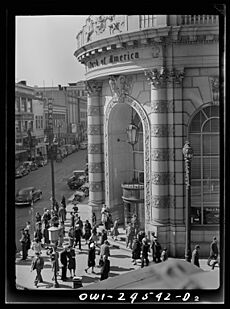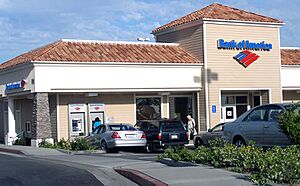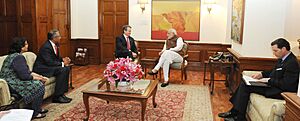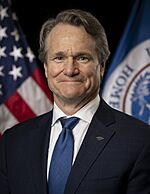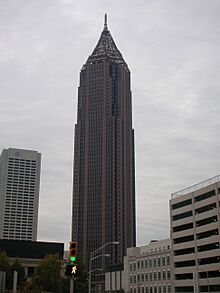Bank of America facts for kids
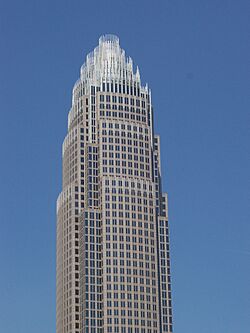
|
|
| Public | |
| Traded as |
|
| ISIN | ISIN: [https://isin.toolforge.org/?language=en&isin=US0605051046 US0605051046] |
| Industry | Financial services |
| Predecessors |
|
| Founded | 1998 (via the merger of BankAmerica & NationsBank) |
| Headquarters | Bank of America Corporate Center,
,
United States
|
|
Number of locations
|
c. 3,800 retail financial centers, c. 15,000 ATMs (2023) |
|
Area served
|
Worldwide |
|
Key people
|
|
| Products |
|
| Revenue | |
|
Operating income
|
|
| AUM | |
| Total assets | |
| Total equity | |
| Owners | Berkshire Hathaway (12.8%) |
|
Number of employees
|
c. 213,000 (2023) |
| Divisions |
|
The Bank of America Corporation (often abbreviated BofA or BoA) is an American multinational investment bank and financial services holding company headquartered at the Bank of America Corporate Center in Charlotte, North Carolina, with investment banking and auxiliary headquarters in Manhattan. The bank was founded by the merger of NationsBank and Bank of America in 1998. It is the second-largest banking institution in the United States and the second-largest bank in the world by market capitalization, both after JPMorgan Chase. Bank of America is one of the Big Four banking institutions of the United States. It serves approximately 10.73% of all American bank deposits, in direct competition with JPMorgan Chase, Citigroup and Wells Fargo. Its primary financial services revolve around commercial banking, wealth management and investment banking.
Through mergers, the oldest branch of the Bank of America franchise can be traced to 1784, when Massachusetts Bank was chartered, the first federally chartered joint-stock owned bank in the United States. Another branch of its history stretches back to the U.S.-based Bank of Italy, founded by Amadeo Pietro Giannini in 1904, which provided various banking options to Italian immigrants who faced service discrimination. Originally headquartered in San Francisco, California, Giannini acquired Banca d'America e d'Italia (Bank of America and Italy) in 1922. The passage of landmark federal banking legislation facilitated a rapid growth in the 1950s, quickly establishing a prominent market share. After suffering a significant loss after the 1998 Russian bond default, BankAmerica, as it was then known, was acquired by the Charlotte-based NationsBank for US$62 billion. Following what was then the largest bank acquisition in history, the Bank of America Corporation was founded. Through a series of mergers and acquisitions, it built upon its commercial banking business by establishing Merrill Lynch for wealth management and Bank of America Merrill Lynch for investment banking in 2008 and 2009, respectively (since renamed BofA Securities).
Both Bank of America and Merrill Lynch Wealth Management retain large market shares in their respective offerings. The investment bank is considered within the "Bulge Bracket" as the third largest investment bank in the world, as of 2018[update]. Its wealth management side manages US$1.081 trillion in assets under management (AUM) as the second largest wealth manager in the world, after UBS. In commercial banking, Bank of America operates—but does not necessarily maintain—retail branches in all 50 states of the United States, the District of Columbia and more than 40 other countries. Its commercial banking footprint encapsulates 46 million consumer and small business relationships at 4,600 banking centers and 16,000 automated teller machines (ATMs).
The bank's large market share, business activities, and economic impact has led to numerous lawsuits and investigations regarding both mortgages and financial disclosures dating back to the 2008 financial crisis. Its corporate practices of servicing the middle class and wider banking community have yielded a substantial market share since the early 20th century. As of August 2018[update], Bank of America has a $313.5 billion market capitalization, making it the 13th largest company in the world. As the sixth largest American public company, it garnered $102.98 billion in sales as of June 2018[update]. Bank of America was ranked No. 25 on the 2020 Fortune 500 rankings of the largest US corporations by total revenue. Likewise, Bank of America was also ranked No. 6 on the 2023 Global 2000 rankings done by Forbes. Bank of America was named the "World's Best Bank" by the Euromoney Institutional Investor in its 2018 Awards for Excellence.
Contents
History
Bank of America, Los Angeles was founded in California in 1923. In 1928, this entity was acquired by Bank of Italy of San Francisco, which took the Bank of America name two years later.
The eastern portion of the Bank of America franchise can be traced to 1784, when Massachusetts Bank was chartered, the first federally chartered joint-stock owned bank in the United States and only the second bank to receive a charter in the United States. This bank became FleetBoston, with which Bank of America merged in 2004. In 1874, Commercial National Bank was founded in Charlotte. That bank merged with American Trust Company in 1958 to form American Commercial Bank. Two years later it became North Carolina National Bank when it merged with Security National Bank of Greensboro. In 1991, it merged with C&S/Sovran Corporation of Atlanta and Norfolk to form NationsBank.
The central portion of the franchise dates to 1910, when Commercial National Bank and Continental National Bank of Chicago merged in 1910 to form Continental & Commercial National Bank, which evolved into Continental Illinois National Bank & Trust.
Bank of Italy
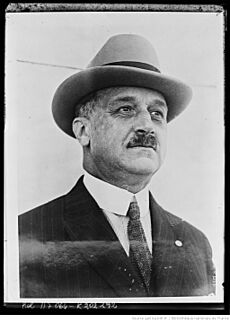
The history of Bank of America dates back to October 17, 1904, when Amadeo Pietro Giannini (1870–1949) founded the Bank of Italy, in San Francisco. In 1922, Bank of America, Los Angeles was established with Giannini as a minority investor. The two banks merged in 1928 and consolidated with other bank holdings to create what would become the largest banking institution in the country.
In 1918, another corporation, Bancitaly Corporation, was organized by A. P. Giannini, the largest stockholder of which was Stockholders Auxiliary Corporation. This company acquired the stocks of various banks located in New York City and certain foreign countries.
In 1928, Giannini merged his bank with Bank of America, Los Angeles, headed by Orra E. Monnette. Bank of Italy was renamed on November 3, 1930, to Bank of America National Trust and Savings Association, which was the only such designated bank in the United States at that time. Giannini and Monnette headed the resulting company, serving as co-chairs.
Expansion in California
Giannini introduced branch banking shortly after 1909 legislation in California allowed for branch banking in the state, establishing the bank's first branch outside San Francisco in 1909 in San Jose. By 1929 the bank had 453 banking offices in California with aggregate resources of over US$1.4 billion. There is a replica of the 1909 Bank of Italy branch bank in History Park in San Jose, and the 1925 Bank of Italy Building is an important downtown landmark. Giannini sought to build a national bank, expanding into most of the western states as well as into the insurance industry, under the aegis of his holding company, Transamerica Corporation.
In 1953 regulators succeeded in forcing the separation of Transamerica Corporation and Bank of America under the Clayton Antitrust Act. The passage of the Bank Holding Company Act of 1956 prohibited banks from owning non-banking subsidiaries such as insurance companies. Bank of America and Transamerica were separated, with the latter company continuing in the insurance sector. However, federal banking regulators prohibited Bank of America's interstate banking activity, and Bank of America's domestic banks outside California were forced into a separate company that eventually became First Interstate Bancorp, later acquired by Wells Fargo and Company in 1996. Only in the 1980s, with a change in federal banking legislation and regulation, could Bank of America again expand its domestic consumer banking activity outside California.
New technologies also allowed the direct linking of credit cards with individual bank accounts. In 1958, the bank introduced the BankAmericard, which changed its name to Visa in 1977. A coalition of regional bankcard associations introduced Interbank in 1966 to compete with BankAmericard. Interbank became Master Charge in 1966 and then Mastercard in 1979.
From February 1970 through September 1971, there were 66 attacks on Bank of America branches in California, including 53 bombings or fire-bombings, and 13 arson fires. There were "few injuries" and the property damage cost about $500,000, fourth-fifths of which was from the burning of the Isla Vista branch during a February 1970 riot.
Expansion outside California
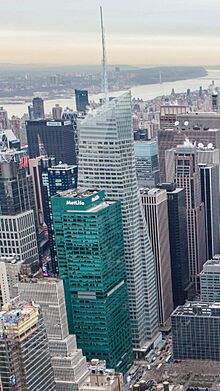
Following the passage of the Bank Holding Company Act of 1956 by the US Congress, BankAmerica Corporation was established for the purpose of owning and operating Bank of America and its subsidiaries.
Bank of America expanded outside California in 1983, with its acquisition, orchestrated in part by Stephen McLin, of Seafirst Corporation of Seattle, Washington, and its wholly owned banking subsidiary, Seattle-First National Bank. Seafirst was at risk of seizure by the federal government after becoming insolvent due to a series of bad loans to the oil industry. BankAmerica continued to operate its new subsidiary as Seafirst rather than Bank of America until the 1998 merger with NationsBank.
BankAmerica experienced huge losses in 1986 and 1987 due to the placement of a series of bad loans in the Third World. The company fired its CEO, Sam Armacost, in 1986. Though Armacost blamed the problems on his predecessor, A. W. (Tom) Clausen, Clausen was appointed to replace Armacost. The losses resulted in a huge decline of BankAmerica stock, making it vulnerable to a hostile takeover. First Interstate Bancorp of Los Angeles (which had originated from banks once owned by BankAmerica), launched such a bid in the fall of 1986, although BankAmerica rebuffed it, mostly by selling operations. It sold its FinanceAmerica subsidiary to Chrysler and the brokerage firm Charles Schwab and Co. back to Mr. Schwab. It also sold Bank of America and Italy to Deutsche Bank. By the time of the 1987 stock-market crash, BankAmerica's share price had fallen to $8, but by 1992 it had rebounded mightily to become one of the biggest gainers of that half-decade.
BankAmerica's next big acquisition came in 1992. The company acquired Security Pacific Corporation and its subsidiary Security Pacific National Bank in California and other banks in Arizona, Idaho, Oregon, and Washington, which Security Pacific had acquired in a series of acquisitions in the late 1980s. This represented, at the time, the largest bank acquisition in history. Federal regulators, however, forced the sale of roughly half of Security Pacific's Washington subsidiary, the former Rainier Bank, as the combination of Seafirst and Security Pacific Washington would have given BankAmerica too large a share of the market in that state. The Washington branches were divided and sold to West One Bancorp (now U.S. Bancorp) and KeyBank. Later that year, BankAmerica expanded into Nevada by acquiring Valley Bank of Nevada.
In 1994, BankAmerica acquired the Continental Illinois National Bank and Trust Co. of Chicago. At the time, no bank possessed the resources to bail out Continental, so the federal government operated the bank for nearly a decade. Illinois then regulated branch banking extremely heavily, so Bank of America Illinois was a single-unit bank until the 21st century. BankAmerica moved its national lending department to Chicago in an effort to establish a financial beachhead in the region.
These mergers helped BankAmerica Corporation to once again become the largest U.S. bank holding company in terms of deposits, but the company fell to second place in 1997 behind North Carolina's fast-growing NationsBank Corporation, and to third in 1998 behind First Union Corp.
On the capital markets side, the acquisition of Continental Illinois helped BankAmerica to build a leveraged finance origination- and distribution business, which allowed the firm's existing broker-dealer, BancAmerica Securities (originally named BA Securities), to become a full-service franchise. In addition, in 1997, BankAmerica acquired Robertson Stephens, a San Francisco–based investment bank specializing in high technology for $540 million. Robertson Stephens was integrated into BancAmerica Securities, and the combined subsidiary was renamed "BancAmerica Robertson Stephens".
Merger of NationsBank and BankAmerica
In 1997, BankAmerica lent investment management firm D. E. Shaw & Co. $1.4 billion to run various businesses for the bank. However, D.E. Shaw suffered significant loss after the 1998 Russia bond default. NationsBank of Charlotte acquired BankAmerica in 1998 in what was the largest bank acquisition in history at that time.
While NationsBank was the nominal survivor, the merged bank took the better-known name of Bank of America. Hence, the holding company was renamed Bank of America Corporation, while NationsBank, N.A. merged with Bank of America NT&SA to form Bank of America, N.A. as the remaining legal bank entity. The combined bank operates under Federal Charter 13044, which was granted to Giannini's Bank of Italy on March 1, 1927. However, the merged company was and still is headquartered in Charlotte, and retains NationsBank's pre-1998 stock price history. All U.S. Securities and Exchange Commission (SEC) filings before 1998 are listed under NationsBank, not Bank of America. NationsBank president, chairman, and CEO Hugh McColl, took on the same roles with the merged company.
In 1998, Bank of America possessed combined assets of $570 billion, as well as 4,800 branches in 22 U.S. states. Despite the size of the two companies, federal regulators insisted only upon the divestiture of 13 branches in New Mexico, in towns that would be left with only a single bank following the combination. These branches were sold to BOK Financial Corporation, which operates them under the name "Bank of Albuquerque". The broker-dealer, NationsBanc Montgomery Securities, was named Banc of America Securities in 1998.
2001 to 2007
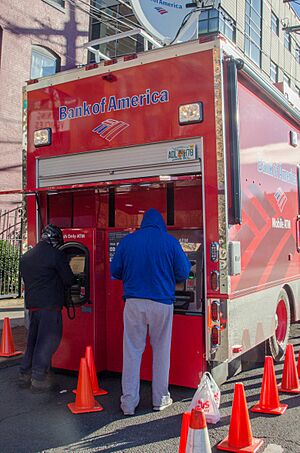
In 2001, McColl stepped down as CEO and named Ken Lewis as his successor. In 2004, Bank of America announced it would purchase Boston-based bank FleetBoston Financial for $47 billion in cash and stock. By merging with Bank of America, all of its banks and branches were given the Bank of America logo. At the time of merger, FleetBoston was the seventh largest bank in United States with $197 billion in assets, over 20 million customers and revenue of $12 billion. Hundreds of FleetBoston workers lost their jobs or were demoted, according to The Boston Globe.
On June 30, 2005, Bank of America announced it would purchase credit card giant MBNA for $35 billion in cash and stock. The Federal Reserve Board gave final approval to the merger on December 15, 2005, and the merger closed on January 1, 2006. The acquisition of MBNA provided Bank of America a leading domestic and foreign credit card issuer. The combined Bank of America Card Services organization, including the former MBNA, had more than 40 million U.S. accounts and nearly $140 billion in outstanding balances. Under Bank of America, the operation was renamed FIA Card Services.
Bank of America operated under the name BankBoston in many other Latin American countries, including Brazil. In May 2006, Bank of America and Banco Itaú (Investimentos Itaú S.A.) entered into an acquisition agreement, through which Itaú agreed to acquire BankBoston's operations in Brazil, and was granted an exclusive right to purchase Bank of America's operations in Chile and Uruguay, in exchange for Itaú shares. The deal was signed in August 2006.
Prior to the transaction, BankBoston's Brazilian operations included asset management, private banking, a credit card portfolio, and small, middle-market, and large corporate segments. It had 66 branches and 203,000 clients in Brazil. BankBoston in Chile had 44 branches and 58,000 clients and in Uruguay, it had 15 branches. In addition, there was a credit card company, OCA, in Uruguay, which had 23 branches. BankBoston N.A. in Uruguay, together with OCA, jointly served 372,000 clients. While the BankBoston name and trademarks were not part of the transaction, as part of the sale agreement, they cannot be used by Bank of America in Brazil, Chile or Uruguay following the transactions. Hence, the BankBoston name has disappeared from Brazil, Chile and Uruguay. The Itaú stock received by Bank of America in the transactions has allowed Bank of America's stake in Itaú to reach 11.51%. Banco de Boston de Brazil had been founded in 1947.
On November 20, 2006, Bank of America announced the purchase of The United States Trust Company for $3.3 billion, from the Charles Schwab Corporation. US Trust had about $100 billion of assets under management and over 150 years of experience. The deal closed July 1, 2007.
On September 14, 2007, Bank of America won approval from the Federal Reserve to acquire LaSalle Bank Corporation from ABN AMRO for $21 billion. With this purchase, Bank of America possessed $1.7 trillion in assets. A Dutch court blocked the sale until it was later approved in July. The acquisition was completed on October 1, 2007. Many of LaSalle's branches and offices had already taken over smaller regional banks within the previous decade, such as Lansing and Detroit-based Michigan National Bank. The acquisition also included the Chicago Marathon event, which ABN AMRO acquired in 1996. Bank of America took over the event starting with the 2007 race.
The deal increased Bank of America's presence in Illinois, Michigan, and Indiana by 411 branches, 17,000 commercial bank clients, 1.4 million retail customers, and 1,500 ATMs. Bank of America became the largest bank in the Chicago market with 197 offices and 14% of the deposit share, surpassing JPMorgan Chase.
LaSalle Bank and LaSalle Bank Midwest branches adopted the Bank of America name on May 5, 2008.
2007–2010 (Subprime mortgage crisis)
During the subprime mortgage crisis, the bank, under Ken Lewis, made two major acquisitions that would shape the future of the company for the next couple years coming out of the crisis. Specifically the bank was sued by many different parties and made to pay tens of billions of dollars.
Acquisition of Countrywide Financial
On August 23, 2007, the company announced a $2 billion repurchase agreement for Countrywide Financial. This purchase of preferred stock was arranged to provide a return on investment of 7.25% per annum and provided the option to purchase common stock at a price of $18 per share.
On January 11, 2008, Bank of America announced that it would buy Countrywide Financial for $4.1 billion. In March 2008, it was reported that the Federal Bureau of Investigation (FBI) was investigating Countrywide for possible fraud relating to home loans and mortgages. This news did not hinder the acquisition, which was completed in July 2008, giving the bank a substantial market share of the mortgage business, and access to Countrywide's resources for servicing mortgages. The acquisition was seen as preventing a potential bankruptcy for Countrywide. Countrywide, however, denied that it was close to bankruptcy. Countrywide provided mortgage servicing for nine million mortgages valued at $1.4 trillion as of December 31, 2007.
This purchase made Bank of America Corporation the leading mortgage originator and servicer in the U.S., controlling 20–25% of the home loan market. The deal was structured to merge Countrywide with the Red Oak Merger Corporation, which Bank of America created as an independent subsidiary. It has been suggested that the deal was structured this way to prevent a potential bankruptcy stemming from large losses in Countrywide hurting the parent organization by keeping Countrywide bankruptcy remote. Countrywide Financial has changed its name to Bank of America Home Loans.
In December 2011, the Justice Department announced a $335 million settlement with Bank of America over discriminatory lending practice at Countrywide Financial. Attorney General Eric Holder said a federal probe found discrimination against qualified African-American and Latino borrowers from 2004 to 2008. He said that minority borrowers who qualified for prime loans were steered into higher-interest-rate subprime loans.
Acquisition of Merrill Lynch
On September 14, 2008, Bank of America announced its intention to purchase Merrill Lynch & Co., Inc. in an all-stock deal worth approximately $50 billion. Merrill Lynch was at the time within days of collapse, and the acquisition effectively saved Merrill from bankruptcy. Around the same time Bank of America was reportedly also in talks to purchase Lehman Brothers, however a lack of government guarantees caused the bank to abandon talks with Lehman. Lehman Brothers filed for bankruptcy the same day Bank of America announced its plans to acquire Merrill Lynch. This acquisition made Bank of America the largest financial services company in the world. Temasek Holdings, the largest shareholder of Merrill Lynch & Co., Inc., briefly became one of the largest shareholders of Bank of America, with a 3% stake. However, taking a loss Reuters estimated at $3 billion, the Singapore sovereign wealth fund sold its whole stake in Bank of America in the first quarter of 2009.
Shareholders of both companies approved the acquisition on December 5, 2008, and the deal closed January 1, 2009. Bank of America had planned to retain various members of the then Merrill Lynch's CEO, John Thain's management team after the merger. However, after Thain was removed from his position, most of his allies left. The departure of Nelson Chai, who had been named Asia-Pacific president, left just one of Thain's hires in place: Tom Montag, head of sales and trading.
The bank, in its January 16, 2009, earnings release, revealed massive losses at Merrill Lynch in the fourth quarter, which necessitated an infusion of money that had previously been negotiated with the government as part of the government-persuaded deal for the bank to acquire Merrill. Merrill recorded an operating loss of $21.5 billion in the quarter, mainly in its sales and trading operations, led by Tom Montag. The bank also disclosed it tried to abandon the deal in December after the extent of Merrill's trading losses surfaced, but was compelled to complete the merger by the U.S. government. The bank's stock price sank to $7.18, its lowest level in 17 years, after announcing earnings and the Merrill mishap. The market capitalization of Bank of America, including Merrill Lynch, was then $45 billion, less than the $50 billion it offered for Merrill just four months earlier, and down $108 billion from the merger announcement.
Bank of America CEO Kenneth Lewis testified before Congress that he had some misgivings about the acquisition of Merrill Lynch and that federal official pressured him to proceed with the deal or face losing his job and endangering the bank's relationship with federal regulators.
Lewis's statement is backed up by internal emails subpoenaed by Republican lawmakers on the House Oversight Committee. In one of the emails, Richmond Federal Reserve President Jeffrey Lacker threatened that if the acquisition did not go through, and later Bank of America were forced to request federal assistance, the management of Bank of America would be "gone". Other emails, read by Congressman Dennis Kucinich during the course of Lewis' testimony, state that Mr. Lewis had foreseen the outrage from his shareholders that the purchase of Merrill would cause, and asked government regulators to issue a letter stating that the government had ordered him to complete the deal to acquire Merrill. Lewis, for his part, states he didn't recall requesting such a letter.
The acquisition made Bank of America the number one underwriter of global high-yield debt, the third largest underwriter of global equity and the ninth largest adviser on global mergers and acquisitions. As the credit crisis eased, losses at Merrill Lynch subsided, and the subsidiary generated $3.7 billion of Bank of America's $4.2 billion in profit by the end of quarter one in 2009, and over 25% in quarter 3 2009.
On September 28, 2012, Bank of America settled the class-action lawsuit over the Merrill Lynch acquisition and will pay $2.43 billion. This was one of the first major securities class action lawsuits stemming from the financial crisis of 2007–2008 to settle. Many major financial institutions had a stake in this lawsuit, including Chicago Clearing Corporation, hedge funds, and bank trusts, due to the belief that Bank of America stock was a sure investment.
Federal Troubled Asset Relief Program
On January 16, 2009, Bank of America received $20 billion and a guarantee of $118 billion in potential losses from the U.S. government through the Troubled Asset Relief Program (TARP). This was in addition to the $25 billion given to the bank in the fall of 2008 through TARP. The additional payment was part of a deal with the U.S. government to preserve Bank of America's merger with Merrill Lynch. Since then, members of the U.S. Congress have expressed considerable concern about how this money has been spent, especially since some of the recipients have been accused of misusing the bailout money. Then CEO Ken Lewis was quoted as claiming "We are still lending, and we are lending far more because of the TARP program." Members of the U.S. House of Representatives, however, were skeptical and quoted many anecdotes about loan applicants (particularly small business owners) being denied loans and credit card holders facing stiffer terms on the debt in their card accounts.
According to an article in The New York Times published on March 15, 2009, Bank of America received an additional $5.2 billion in government bailout money via the bailout of American International Group.
As a result of its federal bailout and management problems, The Wall Street Journal reported that the Bank of America was operating under a secret "memorandum of understanding" (MOU) from the U.S. government that requires it to "overhaul its board and address perceived problems with risk and liquidity management". With the federal action, the institution has taken several steps, including arranging for six of its directors to resign and forming a Regulatory Impact Office. Bank of America faces several deadlines in July and August and if not met, could face harsher penalties by federal regulators. Bank of America did not respond to The Wall Street Journal story.
On December 2, 2009, Bank of America announced it would repay the entire $45 billion it received in TARP and exit the program, using $26.2 billion of excess liquidity along with $18.6 billion to be gained in "common equivalent securities" (Tier 1 capital). The bank announced it had completed the repayment on December 9. Bank of America's Ken Lewis said during the announcement, "We appreciate the critical role that the U.S. government played last fall in helping to stabilize financial markets, and we are pleased to be able to fully repay the investment, with interest.... As America's largest bank, we have a responsibility to make good on the taxpayers' investment, and our record shows that we have been able to fulfill that commitment while continuing to lend."
Bonus settlement
On August 3, 2009, Bank of America agreed to pay a $33 million fine, without admission or denial of charges, to the U.S. Securities and Exchange Commission (SEC) over the non-disclosure of an agreement to pay up to $5.8 billion of bonuses at Merrill. The bank approved the bonuses before the merger but did not disclose them to its shareholders when the shareholders were considering approving the Merrill acquisition, in December 2008. The issue was originally investigated by New York Attorney General Andrew Cuomo, who commented after the suit and announced a settlement that "the timing of the bonuses, as well as the disclosures relating to them, constituted a 'surprising fit of corporate irresponsibility'" and "our investigation of these and other matters pursuant to New York's Martin Act will continue." Congressman Kucinich commented at the same time that "This may not be the last fine that Bank of America pays for how it handled its merger of Merrill Lynch." A federal judge, Jed Rakoff, in an unusual action, refused to approve the settlement on August 5. A first hearing before the judge on August 10 was at times heated, and he was "sharply critic[al]" of the bonuses. David Rosenfeld represented the SEC, and Lewis J. Liman, son of Arthur L. Liman, represented the bank. The actual amount of bonuses paid was $3.6 billion, of which $850 million was "guaranteed" and the rest was shared among 39,000 workers who received average payments of $91,000; 696 people received more than $1 million in bonuses; at least one person received a more than $33 million bonus.
On September 14, the judge rejected the settlement and told the parties to prepare for trial to begin no later than February 1, 2010. The judge focused much of his criticism on the fact that the fine in the case would be paid by the bank's shareholders, who were the ones that were supposed to have been injured by the lack of disclosure. He wrote, "It is quite something else for the very management that is accused of having lied to its shareholders to determine how much of those victims' money should be used to make the case against the management go away," ... "The proposed settlement," the judge continued, "suggests a rather cynical relationship between the parties: the S.E.C. gets to claim that it is exposing wrongdoing on the part of the Bank of America in a high-profile merger; the bank's management gets to claim that they have been coerced into an onerous settlement by overzealous regulators. And all this is done at the expense, not only of the shareholders but also of the truth."
While ultimately deferring to the SEC, in February 2010, Judge Rakoff approved a revised settlement with a $150 million fine "reluctantly", calling the accord "half-baked justice at best" and "inadequate and misguided". Addressing one of the concerns he raised in September, the fine will be "distributed only to Bank of America shareholders harmed by the non-disclosures, or 'legacy shareholders, an improvement on the prior $33 million while still "paltry", according to the judge. Case: SEC v. Bank of America Corp., 09-cv-06829, United States District Court for the Southern District of New York. Investigations also were held on this issue in the United States House Committee on Oversight and Government Reform, under chairman Edolphus Towns (D-NY) and in its investigative Domestic Policy Subcommittee under Kucinich.
Fraud
In 2010, the U.S. government accused the bank of defrauding schools, hospitals, and dozens of state and local government organizations via misconduct and illegal activities involving the investment of proceeds from municipal bond sales. As a result, the bank agreed to pay $137.7 million, including $25 million to the Internal Revenue Service and $4.5 million to the state attorney general, to the affected organizations to settle the allegations. Former bank official Douglas Campbell pleaded guilty to antitrust, conspiracy, and wire fraud charges. As of January 2011[update], other bankers and brokers are under indictment or investigation.
On October 24, 2012, the top federal prosecutor in Manhattan filed a lawsuit alleging that Bank of America fraudulently cost American taxpayers more than $1 billion when Countrywide Financial sold toxic mortgages to Fannie Mae and Freddie Mac. The scheme was called 'Hustle', or High Speed Swim Lane. On May 23, 2016, the Second U.S. Circuit Court of Appeals ruled that the finding of fact by the jury that low quality mortgages were supplied by Countrywide to Fannie Mae and Freddie Mac in the "Hustle" case supported only "intentional breach of contract," not a fraud. The action, for civil fraud, relied on provisions of the Financial Institutions Reform, Recovery and Enforcement Act. The decision turned on lack of intent to defraud at the time the contract to supply mortgages was made.
Change of CEO
Ken Lewis, who had lost the title of chairman of the board, announced that he would retire as CEO effective December 31, 2009, in part due to controversy and legal investigations concerning the purchase of Merrill Lynch. Brian Moynihan became president and CEO effective January 1, 2010, and afterward credit card charge offs and delinquencies declined in January. Bank of America also repaid the $45 billion it had received from the Troubled Assets Relief Program.
2011 to present
Downsizing (2011 to 2014)
During 2011, Bank of America began conducting personnel reductions of an estimated 36,000 people, contributing to intended savings of $5 billion per year by 2014. In December 2011, Forbes ranked Bank of America's financial wealth 91st out of the nation's largest 100 banks and thrift institutions.
Bank of America cut around 16,000 jobs in a quicker fashion by the end of 2012 as revenue continued to decline because of new regulations and a slow economy. This put a plan one year ahead of time to eliminate 30,000 jobs under a cost-cutting program, called Project New BAC. In the first quarter of 2014, Berkshire bank purchased 20 Bank of America branches in Central and eastern New York for 14.4 million dollars. The branches were from Utica/Rome region and down the Mohawk Valley east to the capital region. In April and May 2014, Bank of America sold two dozen branches in Michigan to Huntington Bancshares. The locations were converted to Huntington National Bank branches in September.
As part of its new strategy Bank of America is focused on growing its mobile banking platform. As of 2014[update], Bank of America has 31 million active online users and 16 million mobile users. Its retail banking branches have decreased to 4,900 as a result of increased mobile banking use and a decline in customer branch visits. By 2018, the number of mobile users has increased to 25.3 million and the number of locations fell to 4,411 at the end of June.
Sale of stake in China Construction Bank
In 2005, Bank of America acquired a 9% stake in China Construction Bank, one of the Big Four banks in China, for US$3 billion. It represented the company's largest foray into China's growing banking sector. Bank of America has offices in Hong Kong, Shanghai, and Guangzhou and was looking to greatly expand its Chinese business as a result of this deal. In 2008, Bank of America was awarded Project Finance Deal of the Year at the 2008 ALB Hong Kong Law Awards. In November 2011, Bank of America announced plans to divest most of its stake in the China Construction Bank.
In September 2013, Bank of America sold its remaining stake in the China Construction Bank for as much as $1.5 billion, marking the firm's full exit from the country.
$17 billion settlement with Justice Department
In August 2014, Bank of America agreed to a near–$17 billion deal to settle claims against it relating to the sale of toxic mortgage-linked securities including subprime home loans, in what was believed to be the largest settlement in U.S. corporate history. The bank agreed with the U.S. Justice Department to pay $9.65 billion in fines, and $7 billion in relief to the victims of the faulty loans which included homeowners, borrowers, pension funds and municipalities. Real estate economist Jed Kolko said the settlement is a "drop in the bucket" compared to the $700 billion in damages done to 11 million homeowners. Since the settlement covered such a substantial portion of the market, he said for most consumers "you're out of luck."
Much of the government's prosecution was based on information provided by three whistleblowers – Shareef Abdou (a senior vice president at the bank), Robert Madsen (a professional appraiser employed by a bank subsidiary), and Edward O'Donnell (a Fannie Mae official). The three men received $170 million in whistleblower awards.
DOD Community Bank
Bank of America has formed a partnership with the United States Department of Defense creating a newly chartered bank DOD Community Bank ("Community Bank") providing full banking services to military personnel at 68 branches and ATM locations on U.S. military installations in Guantanamo Bay Naval Base Cuba, Diego Garcia, Germany, Japan, Italy, Kwajalein Atoll, South Korea, the Netherlands, and the United Kingdom. Even though Bank of America operates Community Bank, customer services are not interchangeable between the two financial institutions, meaning that a Community Bank customer cannot go to a Bank of America branch and withdraw from their account and vice versa. Deposits made into checking and savings accounts are insured by the Federal Deposit Insurance Corporation up to $250,000 despite the fact that none of Community's operating branches are located within the jurisdictional borders of the United States.
Decision not to finance makers of military-style guns
In April 2018, Bank of America announced that it would stop providing financing to makers of military-style weapons such as the AR-15 rifle. In announcing the decision, Bank of America referenced recent mass shootings and said that it wanted to "contribute in any way we can" to reduce them.
Return to expansion (2015–present)

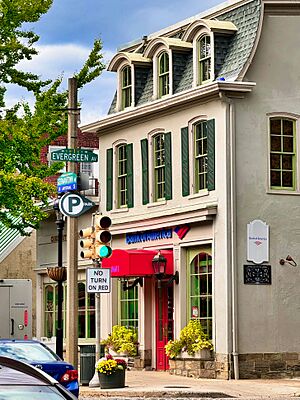
In 2015, Bank of America began expanding organically, opening branches in cities where it previously did not have a retail presence. They started that year in Denver, followed by Minneapolis–Saint Paul and Indianapolis, in all cases having at least one of its Big Four competitors, with Chase Bank being available in Denver and Indianapolis, while Wells Fargo is available in Denver and the Twin Cities. The Twin Cities market is also the home market of U.S. Bancorp, the largest non-Big Four rival.
In January 2018, Bank of America announced an organic expansion of its retail footprint into Pittsburgh and surrounding areas, to supplement its existing commercial lending and investment businesses in the area. Before the expansion, Pittsburgh had been one of the largest US cities without a retail presence by any of the Big Four, with locally based PNC Financial Services (no. 6 nationally) having a commanding market share in the area; this coincided with Chase making a similar expansion into Pittsburgh. By the end of the fiscal year 2020, Bank of America had become Pittsburgh's 16th largest bank by deposits, which considering the dominance of PNC and BNY Mellon in the market is considered relatively impressive. By 2021, Bank of America had moved up to 12th in the market.
In February 2018, Bank of America announced it would expand into Ohio across the state's three biggest cities (Cleveland, Columbus, and Cincinnati), which are strongholds of Chase. Columbus serves as the bank's hub in Ohio due to its central location as the state's capital, its overall size and growth, and an existing Bank of America call center for its credit card division in suburban Westerville. Within a year of entering Ohio, Columbus quickly saw the bank become the 5th largest in the market by deposits, behind only banks either based in Ohio (Fifth Third Bank and locally based Huntington Bancshares) or have a major presence as a result of an acquisition of an Ohio-based institution (Chase and PNC), and ahead of US Bancorp (also with a large presence due to acquiring an Ohio-based bank), Ohio-based KeyBank, and several local institutions. As of 2021, Bank of America is the 9th largest bank by deposits in all of Ohio.
In January 2020, Bank of America hired new advisors whose primary functions are to assist ultra-wealthy clients.
Operations
Bank of America generates 90% of its revenues in its domestic market. The core of Bank of America's strategy is to be the number one bank in its domestic market. It has achieved this through key acquisitions.
Consumer Banking
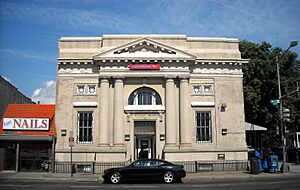
Consumer Banking, the largest division in the company, provides financial services to consumers and small businesses including, banking, investments, merchant services, and lending products including business loans, mortgages, and credit cards. It provides stockbroker services via Merrill Edge, a specific division for investment and related services (such as research and call center counsel) after Merrill Lynch became a subsidiary of Bank of America. The consumer banking division represented 38% of the company's total revenue in 2016. The company earns revenue from interest income, service charges, and fees. In addition, the company is a mortgage servicer. It competes primarily with the retail banking arms of America's three other megabanks: Citigroup, JPMorgan Chase, and Wells Fargo. The Consumer Banking organization includes over 4,600 retail financial centers and approximately 15,900 automated teller machines.
Bank of America is a member of the Global ATM Alliance, a joint venture of several major international banks that provides for reduced fees for consumers using their ATM card or check card at another bank within the Global ATM Alliance when travelling internationally. This feature is restricted to withdrawals using a debit card and users are still subject to foreign currency conversion fees, credit card withdrawals are still subject to cash advance fees and foreign currency conversion fees.
Global Banking

The Global Banking division provides banking services, including investment banking and lending products to businesses. It includes the businesses of Global Corporate Banking, Global Commercial Banking, Business Banking, and Global Investment Banking. The division represented 22% of the company's revenue in 2016.
Before Bank of America's acquisition of Merrill Lynch, the Global Corporate and Investment Banking (GCIB) business operated as Banc of America Securities LLC. The bank's investment banking activities operate under the Merrill Lynch subsidiary and provided mergers and acquisitions advisory, underwriting, capital markets, as well as sales & trading in fixed income and equities markets. Its strongest groups include Leveraged Finance, Syndicated Loans, and mortgage-backed securities. It also has one of the largest research teams on Wall Street. Bank of America Merrill Lynch is headquartered in New York City.
Global Wealth and Investment Management
The Global Wealth and Investment Management (GWIM) division manages the investment assets of institutions and individuals. It includes the businesses of Merrill Lynch Global Wealth Management and U.S. Trust and represented 21% of the company's total revenue in 2016. It is among the 10 largest U.S. wealth managers. It has over $2.5 trillion in client balances. GWIM has five primary lines of business: Premier Banking & Investments (including Bank of America Investment Services, Inc.), The Private Bank, Family Wealth Advisors, and Bank of America Specialist.
Global Markets
The Global Markets division offers services to institutional clients, including trading in financial securities. The division provides research and other services such as securities service, market maker, and risk management using derivatives. The division represented 19% of the company's total revenues in 2016.
Labor
On April 9, 2019, the company announced minimum wage will be increased beginning May 1, 2019, to $17.00 an hour until it reaches a goal of $20.00 an hour in 2021.
Offices
The Bank of America principal executive offices are located in the Bank of America Corporate Center, Charlotte, North Carolina. The skyscraper is located at 100 North Tryon Street, and stands at 871 ft (265 m), having been completed in 1992.
In 2012, Bank of America cut ties to the American Legislative Exchange Council (ALEC).
International offices
Bank of America's Global Corporate and Investment Banking has its U.S. headquarters in Charlotte, European headquarters in Dublin, and Asian headquarters in Hong Kong and Singapore.
Corporate governance
| Name | Position |
|---|---|
| Brian Moynihan | Chairman of the board and chief executive officer, Bank of America Corporation |
| Susan S. Bies | |
| Frank P. Bramble, Sr. | |
| Arnold W. Donald | |
| Monica C. Lozano | |
| Lionel L. Nowell, III | |
| Clayton S. Rose | |
| Thomas D. Woods | |
| Maria T. Zuber | |
| Sharon L. Allen | |
| Jack O. Bovender, Jr. | Lead Independent Director, Bank of America Corporation |
| Pierre J. P. de Weck | |
| Linda P. Hudson | |
| Thomas J. May | |
| Denise L. Ramos | |
| Michael D. White | |
| R. David Yost |
Chief executive officer
List of CEOs
- Hugh McColl (1998–2001)
- Ken Lewis (2001–2009)
- Brian Moynihan (2010– )
Charitable efforts
In 1998, the bank made a ten-year commitment of $350 billion to provide affordable mortgages, build affordable housing, support small businesses and create jobs in disadvantaged neighbourhoods. In 2004, the bank pledged $750 million over a ten-year period for community development lending and affordable housing programs.
In 2007, the bank offered employees a $3,000 rebate for the purchase of hybrid vehicles. The company also provided a $1,000 rebate or a lower interest rate for customers whose homes qualified as energy efficient. In 2007, Bank of America partnered with Brighter Planet to offer an eco-friendly credit card, and later a debit card, which help build renewable energy projects with each purchase. Bank of America has also donated money to help health centers in Massachusetts and made a $1 million donation in 2007 to help homeless shelters in Miami.
In India, Bank of America donates to the preservation and documentation of relics. Since 2010, under the stewardship of Kaku Nakhate, president and head of BoA India, the company has supported arts and culture in the country, including sponsoring the Children's Museum at CSMVS (Chhatrapati Shivaji Maharaj Vastu Sangrahalaya, formerly known as Prince of Wales Museum).
Competition
Bank of America's major competitors are Wells Fargo, Santander, PNC Financial Services, Ally Financial, Capital One, JPMorgan Chase Bank, US Bank, Citizens Financial Group, Citigroup, M&T Bank, and Truist.
Notable buildings
Notable buildings which Bank of America currently occupies include:
- Bank of America Tower in Phoenix, Arizona
- 9454 Wilshire Boulevard in Beverly Hills, California
- Bank of America Center in Los Angeles, California
- Transamerica Pyramid, in San Francisco
- 555 California Street, formerly the Bank of America Center and world headquarters, in San Francisco, California
- City Place I, also known as United Healthcare Center, in Hartford, Connecticut (the tallest building in Connecticut)
- Bank of America Plaza in Fort Lauderdale, Florida
- Bank of America Tower in Jacksonville, Florida
- Bank of America Financial Center (Brickell) and Bank of America Museum Tower (Downtown Miami) in Miami, Florida
- Bank of America Center in Orlando, Florida
- Bank of America Tower in St. Petersburg, Florida
- Bank of America Plaza in Tampa, Florida
- Bank of America Plaza in Atlanta, Georgia
- Bank of America Building, formerly the LaSalle Bank Building in Chicago, Illinois
- One City Center, often called the Bank of America building due to signage rights, in Portland, Maine
- Bank of America Building in Baltimore, Maryland
- Bank of America Plaza in St Louis, Missouri
- Bank of America Tower in Albuquerque, New Mexico
- Bank of America Tower in New York City
- Bank of America Corporate Center in Charlotte, North Carolina (the corporate headquarters)
- Bank of America Plaza in Charlotte, North Carolina
- Bank of America Tower in Charlotte, North Carolina
- Hearst Tower in Charlotte, North Carolina
- Bank of America Plaza in Dallas, Texas
- Bank of America Tower in Midland, Texas
- Bank of America Plaza in San Antonio, Texas
- Bank of America Fifth Avenue Plaza in Seattle, Washington
- Columbia Center in Seattle, Washington
- Bank of America Tower in Hong Kong
In 2010, the bank completed construction of the 1 Bank of America Center in Charlotte center city. The tower, and accompanying hotel, is a LEED-certified building.
Former buildings
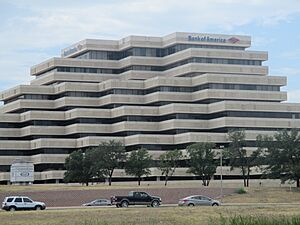
The Robert B. Atwood Building in Anchorage, Alaska, was at one time named the Bank of America Center, renamed in conjunction with the bank's acquisition of building tenant Security Pacific Bank. This particular branch was later acquired by Alaska-based Northrim Bank and moved across the street to the Linny Pacillo Parking Garage.
The Bank of America Building (Providence) opened in 1928 as the Industrial Trust Building and remains the tallest building in Rhode Island. Through a number of mergers, it was later known as the Industrial National Bank building and the Fleet Bank building. The building was leased by Bank of America from 2004 to 2012 and has been vacant since March 2013. The building is commonly known as the Superman Building based on a popular belief that it was the model for the Daily Planet building in the Superman comic books.
The Miami Tower, iconic in its appearance in Miami Vice, was known as the Bank of America Tower for many years. It is located in Downtown Miami. On April 18, 2012, the AIA's Florida Chapter placed it on its list of Florida Architecture: 100 Years. 100 Places as the Bank of America Tower.
TC Energy Center in Houston, Texas, was previously known as Bank of America Center until Bank of America ended its tenancy in the building in June 2019. Designed in the postmodern architecture style by renowned architect Philip Johnson, the building has been one of the most recognizable landmarks of the downtown Houston skyline since it was completed in 1983.
See also
 In Spanish: Bank of America para niños
In Spanish: Bank of America para niños
- List of members ATM Industry Association (ATMIA)
- BAML Capital Partners
- Bank of America (Asia)
- Big Four banks
- Calibuso, et al. v. Bank of America Corp., et al.
- List of bank mergers in the United States
- List of largest banks in the United States


